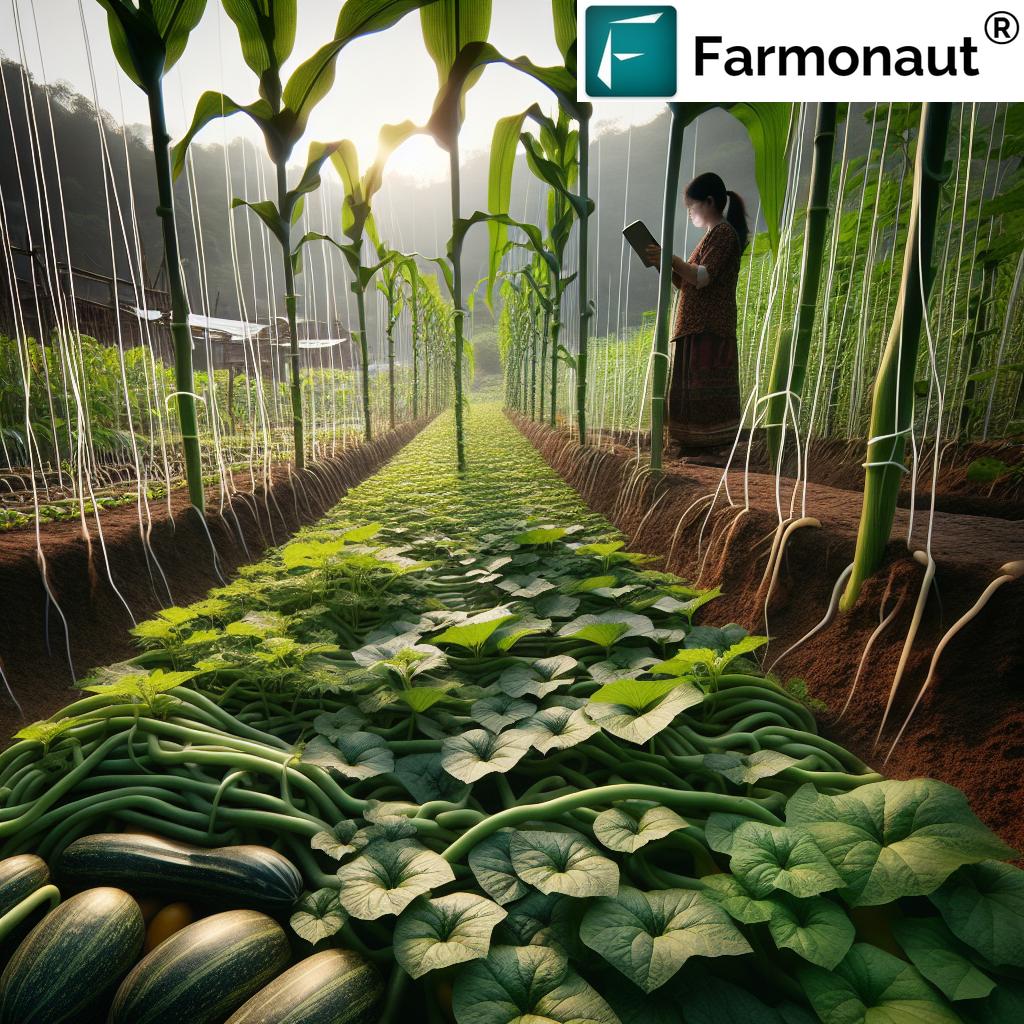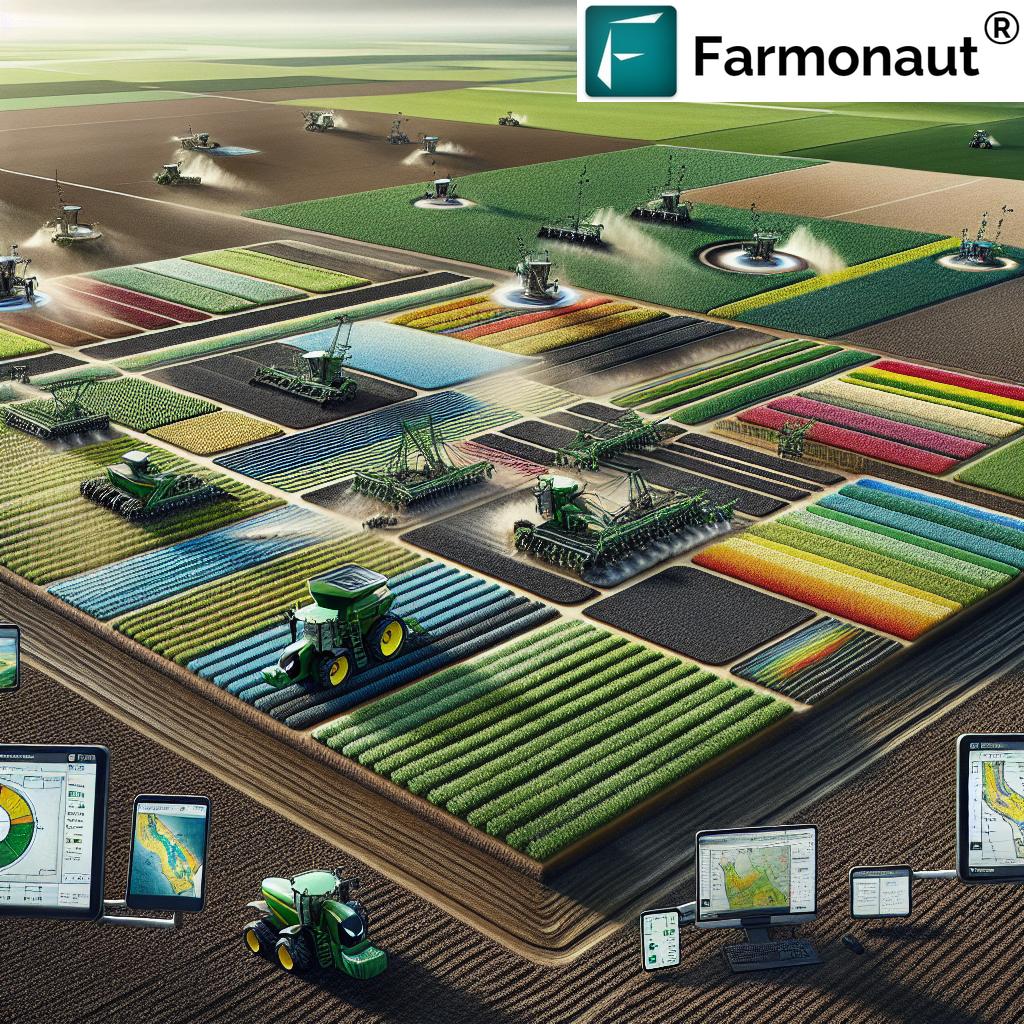Unlocking the Power of Multiple Cropping: A Sustainable Path to Agricultural Productivity and Soil Health

“Multiple cropping can increase land use efficiency by up to 60% compared to single-crop systems.”
In today’s ever-evolving agricultural landscape, we find ourselves at a crucial juncture where sustainable farming practices are not just beneficial but essential. As we delve into the world of multiple cropping, we’ll uncover how this innovative approach to agriculture is revolutionizing the way we think about farming, soil health, and agricultural productivity. Join us on this journey as we explore the multifaceted benefits of polyculture farming techniques and how they can transform your agricultural endeavors.
Understanding Multiple Cropping: A Sustainable Agriculture Practice
Multiple cropping, also known as polyculture, is a farming system where more than one crop is grown on the same piece of land during a single growing season. This approach stands in stark contrast to monocropping, which involves cultivating a single crop in a given area year after year. The concept of multiple cropping is rooted in ancient farming wisdom but has gained renewed interest in recent years due to its numerous benefits for both farmers and the environment.
At its core, multiple cropping is about optimizing land use, enhancing soil fertility, and boosting overall agricultural productivity. By implementing various polyculture farming techniques, farmers can create diverse ecosystems within their fields, leading to improved pest management, increased biodiversity, and more resilient crop systems.
Types of Multiple Cropping Systems
There are several types of multiple cropping systems, each with its unique characteristics and benefits. Let’s explore some of the most common and effective methods:
- Intercropping: This involves growing two or more crops simultaneously in the same field, often in alternating rows or strips.
- Relay Cropping: In this system, a second crop is planted into a standing crop before it’s harvested.
- Mixed Cropping: Multiple crops are grown together without any distinct row arrangement.
- Sequential Cropping: Two or more crops are grown in sequence on the same field within a year.
- Double Cropping: Two crops are grown on the same land in one year, one after the other.
Each of these systems offers unique advantages, and the choice often depends on factors such as climate, soil type, available resources, and specific crop combinations.
The Benefits of Multiple Cropping
Implementing multiple cropping practices can lead to a wide array of benefits for farmers, the environment, and even consumers. Let’s delve into some of the key advantages:
- Increased Land Use Efficiency: By growing multiple crops on the same land, farmers can significantly increase their overall yield per unit area.
- Enhanced Soil Health: Different crops have varying nutrient requirements and root systems, which can help improve soil structure and fertility over time.
- Improved Pest and Disease Management: Diversity in cropping can disrupt pest life cycles and reduce the spread of crop-specific diseases.
- Risk Mitigation: Growing multiple crops can help spread the risk of crop failure due to adverse weather conditions or market fluctuations.
- Increased Biodiversity: Polyculture systems support a wider range of plant and animal species, contributing to overall ecosystem health.
- Better Resource Utilization: Different crops can utilize resources like water, sunlight, and nutrients more efficiently when grown together.
- Extended Growing Season: By implementing relay or sequential cropping, farmers can extend their productive growing season.

Implementing Multiple Cropping: Strategies and Considerations
While the benefits of multiple cropping are clear, successful implementation requires careful planning and consideration. Here are some key strategies and factors to keep in mind:
- Crop Selection: Choose crops that are compatible in terms of growth requirements, root systems, and nutrient needs.
- Timing: Proper timing of planting and harvesting is crucial, especially in relay and sequential cropping systems.
- Spatial Arrangement: In intercropping, consider the optimal spacing between different crops to minimize competition and maximize resource utilization.
- Soil Management: Implement practices like crop rotation and cover cropping to maintain and improve soil health.
- Water Management: Ensure efficient irrigation systems that can cater to the needs of multiple crops.
- Pest and Disease Control: Develop integrated pest management strategies that work across your crop combinations.
- Machinery and Equipment: Ensure you have the necessary tools and equipment to manage multiple crops efficiently.
“Implementing crop rotation in multiple cropping can reduce pest populations by 30-50% without chemical pesticides.”
The Role of Precision Agriculture in Multiple Cropping
Precision agriculture technology plays a crucial role in optimizing multiple cropping systems. By leveraging advanced tools and data-driven insights, farmers can make more informed decisions about planting, fertilization, and harvesting. Here’s how precision agriculture enhances multiple cropping practices:
- Satellite-Based Crop Monitoring: Remote sensing technology allows farmers to track crop health across different zones within their fields.
- Soil Mapping: Detailed soil analysis helps in making informed decisions about crop placement and rotation strategies.
- Variable Rate Technology: This allows for precise application of inputs like fertilizers and water based on the specific needs of different crops.
- Weather Forecasting: Advanced weather prediction models help in planning planting and harvesting schedules for multiple crops.
- Yield Monitoring: Accurate yield data for different crops helps in evaluating the success of multiple cropping strategies.
At Farmonaut, we understand the importance of precision agriculture in multiple cropping systems. Our satellite-based farm management solutions provide real-time insights into crop health, soil moisture levels, and other critical metrics. This data empowers farmers to make informed decisions about their multiple cropping practices, ultimately leading to optimized resource use and improved yields.
Crop Rotation Strategies in Multiple Cropping
Crop rotation is a fundamental aspect of successful multiple cropping systems. By carefully planning the sequence of crops grown on a particular piece of land, farmers can maximize the benefits of polyculture while minimizing potential drawbacks. Here are some key crop rotation strategies:
- Alternating Nutrient Demands: Rotate between crops with high and low nutrient demands to prevent soil depletion.
- Varying Root Systems: Alternate between shallow-rooted and deep-rooted crops to improve soil structure at different depths.
- Pest and Disease Management: Plan rotations that break pest and disease cycles specific to certain crops.
- Nitrogen Fixation: Include legumes in the rotation to naturally replenish soil nitrogen levels.
- Weed Control: Incorporate crops with different growth habits to suppress weed growth naturally.
By implementing these strategies, farmers can enhance soil fertility, reduce pest pressures, and maintain consistent yields across multiple growing seasons.
Soil Health and Multiple Cropping
One of the most significant benefits of multiple cropping is its positive impact on soil health. By growing diverse crops in the same field, farmers can:
- Improve soil structure through varied root systems
- Enhance soil organic matter content
- Increase soil microbial activity
- Reduce soil erosion
- Improve water retention capacity
These improvements in soil health not only benefit the current crops but also contribute to long-term agricultural sustainability. Healthy soils are more resilient to climate change impacts and can support higher yields with fewer inputs over time.
Biodiversity and Ecosystem Services in Multiple Cropping Systems
Multiple cropping systems play a crucial role in enhancing biodiversity on farms. This increased biodiversity brings with it a range of ecosystem services that benefit both the farm and the surrounding environment:
- Pollination: Diverse cropping systems attract a wider range of pollinators, improving crop yields and supporting local ecosystems.
- Natural Pest Control: A diverse farm environment supports natural predators of crop pests, reducing the need for chemical pesticides.
- Soil Microbiome: Multiple cropping enhances soil microbial diversity, which is crucial for nutrient cycling and plant health.
- Wildlife Habitat: Polyculture systems provide better habitats for local wildlife, contributing to overall ecosystem health.
- Carbon Sequestration: Diverse cropping systems can increase soil organic carbon, helping mitigate climate change.
By promoting biodiversity through multiple cropping, farmers not only improve their own production systems but also contribute to broader environmental conservation efforts.
Challenges and Solutions in Multiple Cropping
While multiple cropping offers numerous benefits, it also comes with its own set of challenges. Here are some common issues farmers may face and potential solutions:
- Increased Management Complexity:
- Solution: Utilize farm management software and precision agriculture tools to streamline operations.
- Competition Between Crops:
- Solution: Carefully select compatible crop combinations and optimize spatial arrangements.
- Equipment Limitations:
- Solution: Invest in versatile machinery or consider custom farming services for specialized operations.
- Market Demand Fluctuations:
- Solution: Diversify crop selection to spread risk and explore value-added processing options.
- Knowledge and Skill Requirements:
- Solution: Engage in continuous learning through workshops, extension services, and online resources.
By addressing these challenges proactively, farmers can maximize the benefits of multiple cropping while minimizing potential drawbacks.
The Future of Multiple Cropping: Integrating Technology and Traditional Wisdom
As we look to the future of agriculture, multiple cropping stands out as a sustainable practice that combines traditional farming wisdom with modern technology. The integration of precision agriculture tools, remote sensing, and AI-driven analytics is set to revolutionize how we approach multiple cropping systems.
Farmonaut’s satellite-based crop monitoring solutions, for instance, allow farmers to track the health and progress of multiple crops simultaneously. Our advanced analytics can help identify optimal crop combinations, predict potential issues, and provide actionable insights for better farm management.
As we continue to face challenges like climate change, food security, and environmental degradation, multiple cropping offers a sustainable path forward. By embracing these practices and leveraging cutting-edge technology, we can create more resilient, productive, and environmentally friendly agricultural systems.
Comparison of Multiple Cropping Systems
| Cropping System | Description | Benefits | Challenges | Suitable Crops | Estimated Yield Increase (%) | Soil Health Impact | Pest Management Effectiveness | Biodiversity Impact | Technology Integration |
|---|---|---|---|---|---|---|---|---|---|
| Intercropping | Growing two or more crops simultaneously in alternating rows | Efficient land use, improved soil health | Competition between crops | Maize-beans, wheat-chickpeas | 20-40 | High | High | High | Remote sensing, precision planting |
| Relay Cropping | Planting a second crop before harvesting the first | Extended growing season, maximized land use | Timing challenges | Rice-wheat, cotton-wheat | 15-30 | Medium | Medium | Medium | Weather forecasting, crop modeling |
| Mixed Cropping | Growing multiple crops together without distinct row arrangement | Improved biodiversity, natural pest control | Harvesting difficulties | Cereals-legumes, various vegetables | 10-25 | High | High | High | Multispectral imaging, AI-based crop identification |
| Sequential Cropping | Growing two or more crops in sequence within a year | Efficient resource use, improved soil fertility | Short turnaround time between crops | Soybean-wheat, rice-pulses | 30-50 | Medium | Medium | Low | Soil moisture sensors, automated irrigation |
| Double Cropping | Growing two crops on the same land in one year | Increased annual yield, efficient land use | Intensive management required | Corn-soybeans, wheat-soybeans | 40-60 | Medium | Low | Low | Yield mapping, variable rate technology |
This comprehensive comparison highlights the unique characteristics of each multiple cropping system, helping farmers choose the most suitable approach for their specific needs and conditions.
Implementing Multiple Cropping with Farmonaut
At Farmonaut, we’re committed to supporting farmers in their journey towards more sustainable and productive agricultural practices. Our suite of tools and services can significantly enhance the implementation and management of multiple cropping systems:
- Satellite-Based Crop Monitoring: Our advanced remote sensing technology allows you to track the health and progress of multiple crops simultaneously, enabling timely interventions and optimized resource allocation.
- AI-Powered Advisory: Our Jeevn AI system provides personalized recommendations for crop combinations, planting schedules, and management practices tailored to your specific field conditions.
- Weather Forecasting: Access accurate, localized weather predictions to help you plan your multiple cropping activities with confidence.
- Soil Health Tracking: Monitor soil fertility and structure over time, ensuring your multiple cropping system is contributing to long-term soil health.
- Yield Estimation: Get accurate yield predictions for your various crops, helping you make informed decisions about harvesting and marketing.
By leveraging Farmonaut’s technology, you can take your multiple cropping practices to the next level, maximizing productivity while ensuring sustainable land management.
Conclusion: Embracing Multiple Cropping for a Sustainable Future
As we’ve explored throughout this article, multiple cropping offers a powerful solution to many of the challenges facing modern agriculture. By embracing polyculture farming techniques, we can increase agricultural productivity, enhance soil health, promote biodiversity, and contribute to a more sustainable food system.
The journey towards implementing successful multiple cropping systems may seem daunting, but with the right knowledge, tools, and support, it’s an achievable goal for farmers of all scales. By combining traditional wisdom with cutting-edge technology, we can create resilient, productive, and environmentally friendly agricultural systems that will serve us well into the future.
We encourage you to explore the possibilities of multiple cropping on your own farm. Whether you’re looking to diversify your crop portfolio, improve soil health, or increase overall productivity, multiple cropping offers a path forward. And remember, Farmonaut is here to support you every step of the way with our advanced satellite-based monitoring and AI-powered advisory services.
Let’s work together to unlock the power of multiple cropping and pave the way for a more sustainable and productive agricultural future.
Ready to revolutionize your farming practices with multiple cropping? Explore Farmonaut’s solutions today:
For developers interested in integrating our satellite and weather data into their own systems, check out our API and API Developer Docs.
FAQs About Multiple Cropping
- What is the main difference between multiple cropping and monocropping?
Multiple cropping involves growing two or more crops on the same piece of land during a single growing season, while monocropping is the practice of growing a single crop in the same field year after year.
- How does multiple cropping improve soil health?
Multiple cropping enhances soil health by improving soil structure through diverse root systems, increasing organic matter content, and promoting beneficial soil microbial activity.
- Can multiple cropping help in pest management?
Yes, multiple cropping can significantly reduce pest populations by disrupting pest life cycles and creating habitats for beneficial insects that prey on crop pests.
- What role does technology play in multiple cropping systems?
Technology, such as satellite-based crop monitoring and AI-powered advisory systems, helps farmers optimize their multiple cropping practices by providing real-time data on crop health, soil conditions, and weather patterns.
- Is multiple cropping suitable for all types of farms?
While multiple cropping can be adapted to various farm sizes and types, its suitability depends on factors such as climate, soil conditions, available resources, and market demand for different crops.











